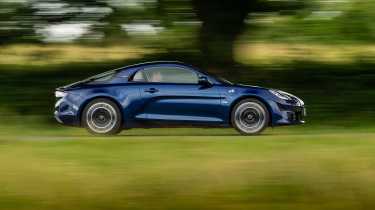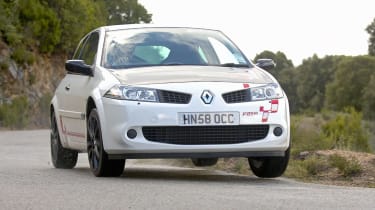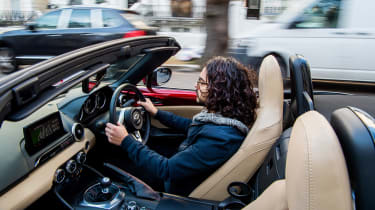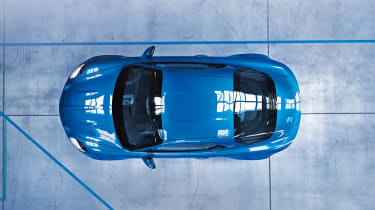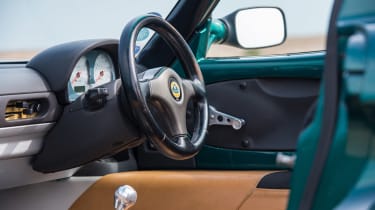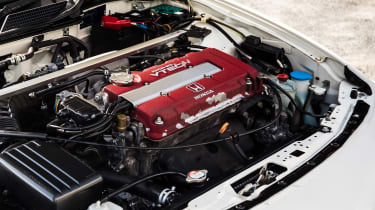What makes a great driver's car? Breaking down the elements of our favourite performance cars
What we actually need for a great drive is less, not more, as we reveal what makes for a brilliant driving car by the experts that know best
This passion for driving we all share, it’s sort of inbuilt, hard-wired, but we know what sustains it. We’ve all experienced moments of pure joy at the wheel, revelatory, unforgettable seconds of perfection when it all comes together – the car, the road and you. And so it sticks fast, leaves you wanting more.
We still crave those moments even if we’ve driven many cars on many roads. It can be the sound of a car echoing off tunnel walls, the feeling of a wonderful engine working hard, a perfectly executed downshift, or just seeing the car’s reflection in shop windows… but what really does it for us here at evo – and probably most of you too – is what happens in the corners.
It doesn’t get any better than the feeling of the car perfectly poised beneath you, its attitude from turn-in to apex to exit determined by your brake, steering and throttle inputs, those inputs guided by feedback through the wheel and seat that tell you the car has got this, was born to do this, was honed by engineers who love driving. That’s what releases the endorphins. That’s the thrill of driving. Question is: what’s the car?
> 'The GMA T.50 will be brilliant, but could the Aston Martin Valkyrie be a more exciting car?'
We imagined driving a loop of our favourite A- and B-roads and asked ourselves: what would we choose? What would deliver that poise, that feel and feedback, corner after corner? What would engage and reward at all speeds? What do we need rather than want? We brainstormed the options, eliminating cars that miss the mark to varying degrees, while honing in on those that would hit the bullseye.
Our shortlist of the most desirable cars quickly revealed some common traits and a pattern. For starters, it contained mostly relatively modest cars. In no particular order: original Lotus Elise and Exige, Lotus Elise Club Racer, BMW E30 M3, Honda Integra Type R, Porsche 968 and 911 Club Sport, Porsche Cayman R, Alpine A110, Caterham Sevens (assorted), Ford Puma, Renault Clio Williams, Clio Trophy and Mégane R26.R, Subaru Impreza RB5 and P1, Peugeot 106 and 306 Rallye, Lotus Elan (’60s original)…
Spot the trend? There’s only one new car, the Alpine A110 (the Caterhams are only new in drivetrain). And the common traits? One is that they all ride exceptionally well, but there are more obvious similarities such as they are all reasonably small and light and not especially powerful.
This is at odds with the new car market. In the last ten years, building SUVs has boomed, while building lightweight cars has waned. Even in driver’s cars it seems that every new model year brings increased power, increased grip and cars that are physically bigger. It feels like we as enthusiasts should be cheering this evolution, applauding ever-greater performance and grip and faster Nürburgring lap times. But more power and grip just means you have to be driving harder and faster to get to that point where the car is dancing beneath you. Similarly, the physical upscaling of cars (and their proportionate increase in weight) makes them less exploitable; our roads are no wider than they used to be, our speed limits no higher.
This got us thinking: is there an optimum specification for a driver’s car; a sweet spot that is just the right size and weight and the right power and grip? And are there essential features and characteristics it needs to deliver the ultimate driving experience? In short, can we create the blueprint for the ideal driver’s car?
We started with that list of our favourite cars. They obviously get quite a lot right so we averaged their vital statistics, which produced some promising figures: a car of around 1100kg with 180bhp per ton wearing a 205-section tyre, wrapped up in a body that casts a shadow no bigger than a Peugeot 306. Configuration? It clearly matters less than these basics because our list includes almost all layouts: front-wheel drive, front-engine/rear-drive, mid-engined, rear-engined, four-wheel drive…
These basics deliver because a smaller car has more road space to play with, and a lack of weight and thus inertia doubles up on this because any slip turns back to grip more quickly. The right amount of grip for the mass and torque should help deliver the desired dynamics: there should be grip enough that the car is responsive and able to exploit its weight distribution in a subtle way or an exaggerated way dependent on circumstances.
So what else do we need in our compact, lightweight car with its adjustable, responsive dynamics and good ride?
All credit to the car makers who are targeting these areas and whose development engineers can set the car up to fully exploit its potential. The Alpine A110 ticks almost all the boxes and absolutely nails the execution. It looks small beside a Cayman and lightness is a key factor in its superb dynamics and performance. The Lotus Elise – whose bonded aluminium chassis clearly inspired Alpine – continues to deliver, though the current models seem to be chasing grip at the expense of some dynamic delicacy. Credit, too, to Mazda. The original MX-5 weighed 971kg and 30 years later the current MX-5 is only slightly heavier despite perceived wisdom saying that modern cars are heavier as they meet stricter safety standards.
Based on past glories, you would hope to find some heroes in the hatchback sector, too, but only the Fiesta ST Performance Edition is on the right track. There’s certainly room for more successors to the Renault Sport Clio Trophy and Mégane R26.R – small, light, affordable hatches that combine sublime damping with great agility and poise, rather than ever-more potent and/or expensive hatches such as the AMG A45 and Mégane Trophy-R.
But in truth every sector could benefit from more cars that sit closer to our blueprint. The benefits of lighter, smaller and less powerful cars alone would be many, from lower fuel consumption to reduced component wear to less raw material required simply to make them. But the greatest benefit to people like us would be the increased chance of having one of those memorable drives next time a great road reveals itself in your windscreen.
> Alpine A110 review - style, speed, agility; the French coupe delivers
The key ingredients for a great driver’s car
Ride quality
Something of an underrated commodity, great damping is important because it’s always working for you, smoothing out the bumps on the entry to a corner so you can home in on that apex, soaking up the pressure when maximum torque is unleashed and keeping the car calm and poised over humps and compressions at speed. Great damping keeps the mass of the car in check at all times and is essential in delivering a car’s dynamic character.
Steering feel and fidelity
The steering is the driver’s primary contact with the car. All we want is the ideal ratio, perfectly judged efforts and useful, accurate feedback at all speeds, so that we sense what the car is doing… and what it’s about to do. Tuning great steering is as much an art as it ever was, despite the majority of cars now having electric power steering which offers even greater fine-tuning possibilities. Additionally, throttle, clutch, brake and gearshift should have similar weights and feel for a sense of consistency.
Brake feel
For confidence and precision, the brake pedal needs to access strong braking potential with subtlety and progression. Top-of-the-pedal response needs to inspire confidence; there should be no obvious dead travel, but neither should there be a sharp reaction. The pedal should feel firm and allow easy modulation when using the brakes hard, to fine-tune braking effort and also allow smooth heel-and-toe downshifts.
Gearshift
Great manual shifters are a joy. They’re increasingly rare with the advent of excellent DCTs, but you can still find superb examples that remind you how much more engaged and rewarded you are by a car with a manual shift. Mazda’s MX-5 has always nailed it, and the current model is no exception: short throw, compact gate and a direct, connected feel. It helps that the Mazda’s gearbox is right there beneath the lever, but remote linkages can be superb too, if the car maker invests the time and effort, as Ford did with the Puma and Porsche has often done with the 911.
Seats
A car seat should be so good it simply doesn’t draw attention to itself. Yet surprisingly few manage to combine comfort with unobtrusive support that lets you feel what the car is doing, as well as offering a good range of adjustment so all drivers can find an ideal driving position. There is a lot of weight to be saved – a seat can weigh 20kg, a lightweight ‘race’ seat half that, but it shouldn’t come at the expense of adjustment. A shout-out here for good visibility that helps place the car. There aren’t many advantages of a high-built car but this is one.
Engine
The engine provides more than just the force that gets the car from corner to corner. It should be responsive to the throttle so it can help finely adjust the car’s attitude on and off the throttle, and for this it needs plenty of torque – 160lb ft per ton is a good number. Turbocharged engines easily deliver the torque and the best now have good throttle response, but they still lack engine braking. So, a naturally aspirated engine is still optimum, one that delivers the torque. Bonuses would be light weight, low centre of gravity, smooth-spinning, high revs and a great natural sound.

